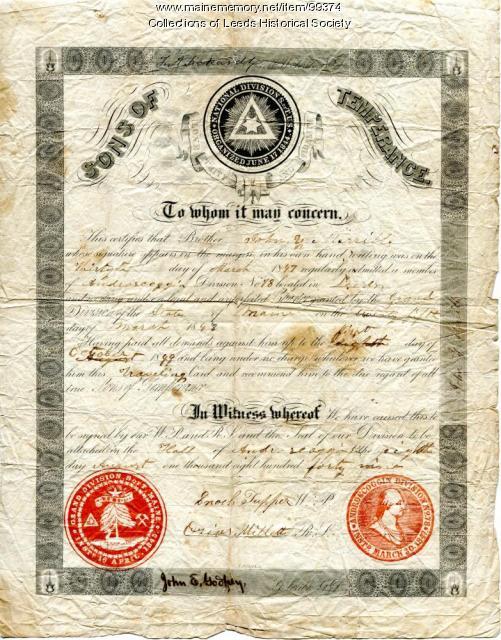Keywords: Temperance Movement
Item 99374
Sons of Temperance certificate, Leeds, 1847
Contributed by: Leeds Historical Society Date: 1847-03-30 Location: Leeds Media: Ink (printer and pen) on paper
Item 15764
Hampden Youth Temperance Society Constitution, 1839
Contributed by: Maine Historical Society Date: 1839 Location: Hampden Media: Ink on paper
Exhibit
Rum, Riot, and Reform - Temperance Membership
"Some were independent, while others linked to national and state movements or organizations. X Youth's Temperance Ribbon Silk Late 19th…"
Exhibit
Rum, Riot, and Reform - Women Leaders and Temperance
"GALLERIES: Politics and Enforcement | Women Leaders and Temperance | Quenching the Thirst | Business as Usual"
Site Page
Life on a Tidal River - Bangor and Social Reform Movements of the 1800s-1900s
"Bangor and the Temperance Movement The Temperance Movement was a social movement whose purpose was to ban the consumption and sale of alcoholic…"
Site Page
Portland Press Herald Glass Negative Collection - Icons & Influencers
"… under owner Colonel Fred Dow (son of infamous Temperance advocate, Neal Dow), but starting with Guy Gannett’s ownership in 1925, the Evening…"
Lesson Plan
Primary Sources: Maine Women's Causes and Influence before 1920
Grade Level: 6-8
Content Area: Social Studies
This lesson plan will give students the opportunity to read and analyze letters, literature, and other primary documents and articles of material culture from the MHS collections relating to the women of Maine between the end of the Revolutionary War through the national vote for women’s suffrage in 1920. Students will discuss issues including war relief (Civil War and World War I), suffrage, abolition, and temperance, and how the women of Maine mobilized for or in some cases helped to lead these movements.
Lesson Plan
Building Community/Community Buildings
Grade Level: 6-8
Content Area: Social Studies
Where do people gather? What defines a community? What buildings allow people to congregate to celebrate, learn, debate, vote, and take part in all manner of community activities? Students will evaluate images and primary documents from throughout Maine’s history, and look at some of Maine’s earliest gathering spaces and organizations, and how many communities established themselves around certain types of buildings. Students will make connections between the community buildings of the past and the ways we express identity and create communities today.












